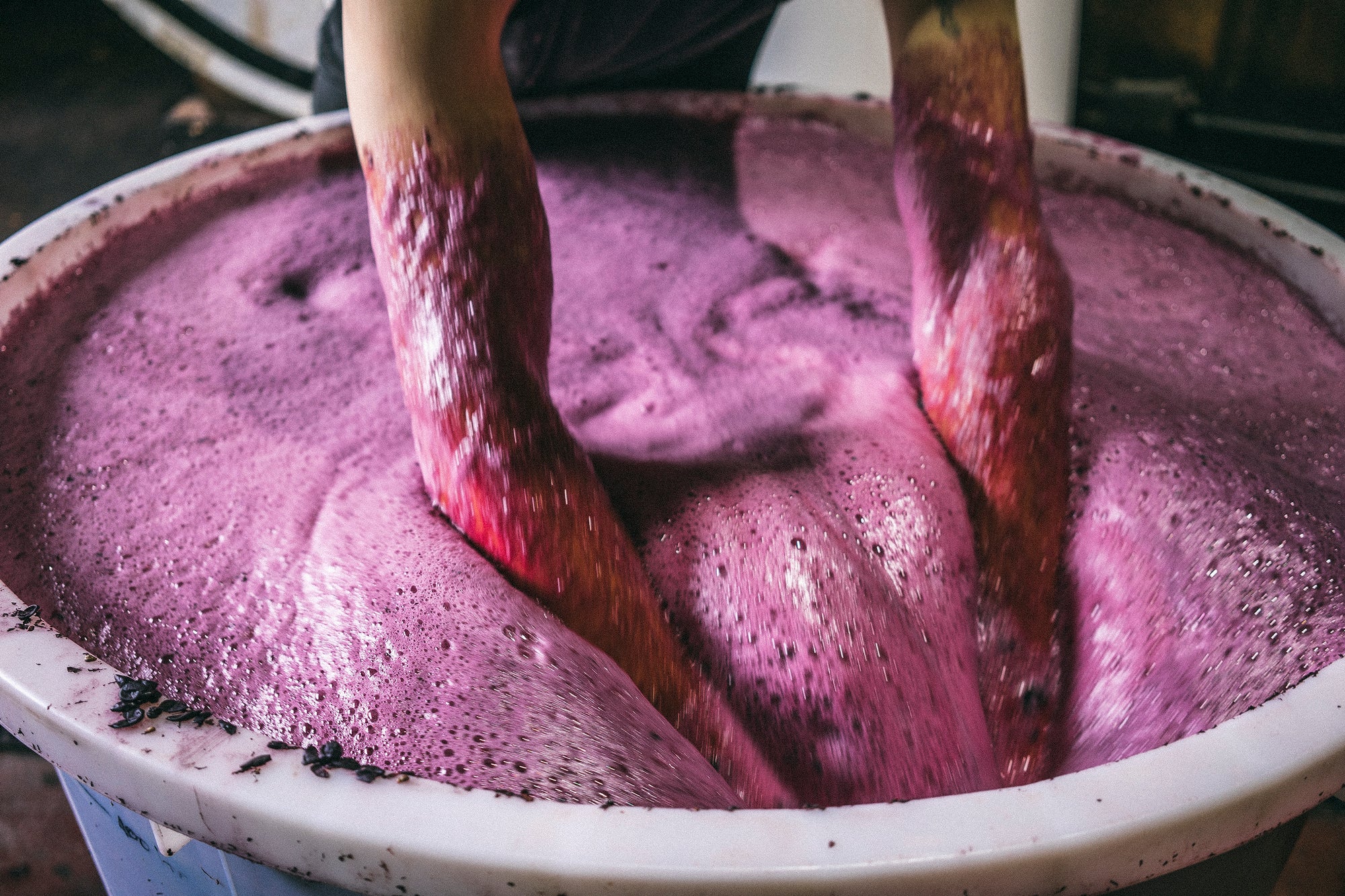

WONDER:
How grapes become wine.
PRIMARY FERMENTATION:
A guide to common magic.
◯
Wine is a magical process of transformation; grapes become wine. There are two major fermentation steps in the making of wine: primary and secondary fermentation. As soon as the grapes leave the vineyard and are crushed in the winery, the miracle of primary fermentation begins.

We pick the grapes at dawn when they're nice and cool. We are after cool temperatures to keep the sweet juices nice and fresh while they make their way over to the winery.
Within a couple of hours after being picked, they’re in the winery and the fun begins. They’re crushed (squishy squashing each little grape) and de-stemmed (a set of whirling fingers literally fling away all the leaves and stems, leaving only the crushed grapes) and pumped into a vessel, their fermenting home. The vessel is initially often stainless steel, but sometimes it’s an open concrete or old wooden vat, or, for many Short Runs batches, a huge bucket equivalent to just 1-3 barrels of wine!

Over the next 10-20 days the grapes undergo 'primary' fermentation. The natural yeasts in the vessel get busy, converting sugar into alcohol and creating CO2. The CO2 bubbles up through the mixture, lifting the grape skins to the surface and creating a thick top layer. Twice a day we plunge the wine with our hands (and arms!) to mix up the skins with the juice so we can extract all the good antioxidants, colours and flavours from the skins. This plunging process also introduces oxygen, which the yeasts need to survive.

Here’s how the magic happens...
WAKE UP.
~ 6-12 hours after crushing
As soon as the grapes are crushed, they release their sweet, sweet juice. This is when the naturals yeasts and bacteria wake up and start eating. They multiply as they go, but in the beginning it’s competitive and they all struggle to survive. There are specific yeast strains that are best suited to grape juice fermentation, especially Saccharomyces Cerevisiae. These yeasts out-compete the others and take control of the Queendom. Once this happens, it’s lift off.

LIFT OFF.
~ 12-48 hours after crushing
Once the strongest yeasts have taken charge, they begin to consume the available glucose and fructose (sugar) and multiply rapidly. For a small yeast population there’s an abundance of food, so they quickly expand in number, producing huge amounts of carbon dioxide as they convert all that sugar into alcohol. Things start to really fire up in this phase and you can smell and see the ferment transforming.

SLOW DOWN.
~ 48 hours after crushing
As the yeast population begins to outgrow the vessel they’re in and run out of food, their population growth slows down and there’s a nice balance between yeast and sugar. Compared to “lift off”, everything progresses far slower; sugar consumption goes slowly, which means alcohol production is also slow and steady. At this point, we transfer at least a portion of our Sauv. Blanc and Chardonnay into hogsheads (300L barrels) to continue fermenting in a carbonic (limited oxygen) environment off-skins. In the hogsheads, if we want to agitate the wine, we can use a special tool to stir everything up.

DIE BACK.
~ 6-14 days after crushing, depending on the ferment
Eventually, the yeast run out of sugar and starting starving. When this happens, the yeasts start to die back. The yeasts also find the rising alcohol content unbearable, whereas certain bacteria love it. These bacteria start their own complimentary fermentation processes, which produce weird and wonderful (well, not always wonderful) layers of complexity as various natural acids and antioxidants emerge and are then consumed themselves. Once this starts happening, we seal our Pét Nats. Under seal, the yeasts that are still alive produce CO2, which creates the bubbly exuberance when you open the bottle.

THE END.
When all the sugars have been consumed, all the yeasts die and sink to the bottom as sediment. This sediment is what we call lees, and it actually acts as a natural preservative against bacterial spoilage and oxidation (too much oxygen). This is where we press the fermented juice from the skins and pour the liquid into a separate vessel (usually either an aged wooden barrel or stainless steel tank), where it goes through a secondary fermentation process called malolactic fermentation (or, “malo”) and everything gets creamier and softer...

Primary fermentation complete.
READ: Part II...
